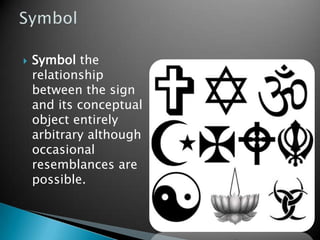Visual communication by asad lashari
- 1. Presented By Asad Lashari
- 2. Generally Visual communication is all around us. In everyday life we perceive media to the large part as a social instrument or technological which addresses the presentation and mediation of information. In these terms we think it is a survival skill. We do not have to visit an art gallery, read an art/design book to experience visual communication.
- 3. We use visual communication to navigate and understand the world. Packaging, signs, logos, bills, mobile phones, advertisements of publishers, internet providers, magazines, newspapers, books, blogs, paintings, photography, film videos, homepages and computer animation.
- 4. Here I give prime theories of Visual communication now I discuss each of them accordingly: Sensory and Perceptual Sensory Gestalt and Constructivism Perceptual Semiotics and Cognitive
- 5. According to Gestalt theory, when we look at anything we immediately organize it into a pattern or shape rather than seeing it as a bunch of individual smaller shapes. Depending on who you talk to, there are five to ten Gestalt principles. We'll discuss the most important ones, starting with what may be the most basic.
- 6. A fundamental distinction we make is to separate a shape or form (the figure) from its surroundings (ground). When there is only one shape to see, we mentally organize it as figure and ground. Typically we identify the smaller, darker shape as figure and the larger, lighter shape as ground.
- 7. Things that look similar we tend to view as connected in some way. There are various types of similarity: shape, size, and color are the most obvious.
- 9. Simply put, things that are closer together we tend to interpreted as being associated. In other words, when things are close together we start to see them as a group rather than individual items.
- 10. Our eyes are inclined to follow lines and curves, so if objects are arranged along paths then we perceive a larger construct and also a sense of movement.
- 11. We prefer to see "closed" figures rather than "open" ones. Our minds easily fill in missing information to complete the shape.
- 12. When we look at anything, we have to piece it together. We do this through a series of rapid eye movements that assemble a blueprint of what we’re looking at, while at the same time comparing the results to memory and past associations. So, in effect, we construct images out of many narrowly focused observations.
- 13. Semiotics is the a field of research that studies signs as an essential part of cultural life and Communication according to semiotics, we can only know culture and reality by means of every message is made of signs; correspondingly, the science of signs termed semiotic deals with those general principles which underlie the structure of all signs whatever, and with the Character of their utilization within messages, as well as with the specifics of the various sign Systems, and of the diverse messages using those different kinds of signs. Signs are the perceived perceivable aspect of communication.
- 14. Iconic sign Appear exactly like the thing itself, but always represents more.
- 15. Indexical signs- indirectly suggests what they mean, acting as cue's to existing knowledge. e.g. Golden arches McDonalds
- 16. Symbol the relationship between the sign and its conceptual object entirely arbitrary although occasional resemblances are possible.
- 17. Perception is not just the result of visual stimuli, but involves a series of mental processes in which we compare what we see to our catalog of memories and perceptions and use those to interpret and analyze. In other words, we understand what we're looking at most easily by comparing it to what we’re familiar with.
- 18. We are constantly on the lookout for things with which we’re familiar. So we see, for example, faces in inanimate objects simply because some features look vaguely like eyes and a mouth, such as the man in the moon.
- 19. Memory Expectation Habituation Selectivity
- 20. Memory an image or impression of one that is remembered.
- 21. Expectation A strong belief about the mental picture of the future.
- 22. Habituation is a decrease in response to a Stimulus after repeated presentations. For example, a new place may initially draw your attention after you become accustomed to this place, you pay less attention This diminished is because of habituation.
- 23. Selectivity Unconscious, automatic act by which large numbers of images enter and leave the mind without being processed – the mind focuses only on significant details within a scene
- 24. The dominance of visual genres over contemporary communication practices is a relatively new phenomenon. The role and functions of visual communication and language are a much debated issue among theoreticians. Although, it is widely acknowledged that Images perform important role in today’s culture, views concerning this subject are strongly polarized.

























